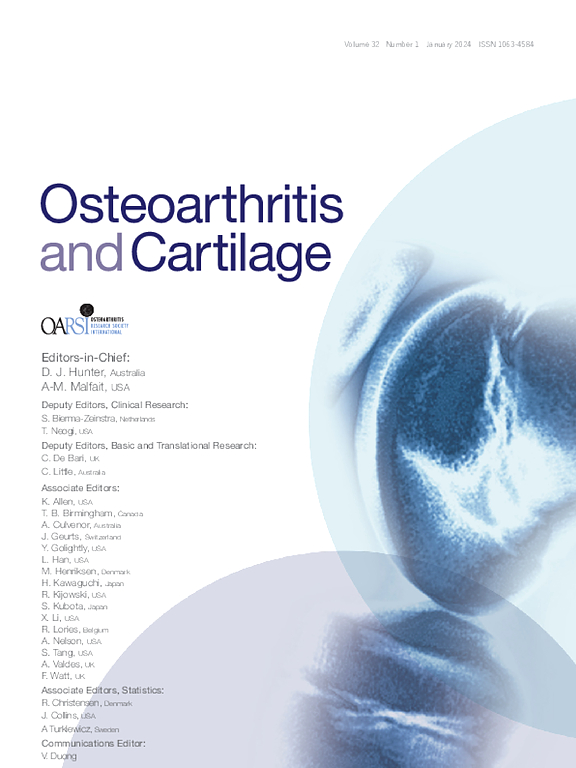Cracking the Pericellular Matrix Code: Exploring how MMP-2, -3, and -7 influence matrix breakdown and biomechanical properties
IF 9
2区 医学
Q1 ORTHOPEDICS
引用次数: 0
Abstract
Introduction
The intricate process of articular cartilage remodeling, pivotal for both physiological functions and osteoarthritis (OA) progression, is orchestrated through a balance of matrix synthesis and breakdown, which is mediated by matrix metalloproteinase enzymes (MMPs). At the heart of this remodeling lies the pericellular matrix (PCM), a specialized microenvironment encapsulating each chondrocyte and composed mainly of collagen type VI and perlecan. The aim of this study was to assess the impact of MMP-2, -3, and -7 on the structural integrity and biomechanical attributes of the PCM.
Methods
Human articular cartilage explants (N = 10 patients) were incubated with activated MMP-2, -3, or -7, individually or in combination. Structural alterations in the PCM were evaluated by immunolabeling. The biomechanical properties of the PCM were measured using atomic force microscopy (AFM).
Results
Collagen type VI structural integrity and fluorescence intensity uniformly decreased across all enzyme groups, while perlecan was selectively affected by MMP-3 and -7. AFM measurements demonstrated decreased PCM stiffness after incubation with individual MMPs, leading to an overall ∼31% reduction in elastic modulus for each enzyme. Combinations of enzymes induced comparable significant biomechanical alterations (∼35%), except for MMP-2+MMP-7.
Discussion
This study highlights the significant influence of MMP-induced alterations in PCM composition on biomechanical properties, mirroring characteristics observed in early OA. Each MMP showed specificity in breaking down PCM, and an intriguing interplay, especially between MMP-2 and -7, indicated reduced efficacy in lowering PCM stiffness. Overall, MMP-2, -3, and -7 directly induce functional and structural PCM modifications.
破解细胞周基密码:探索 MMP-2、-3 和 -7 如何影响基质分解和生物力学特性。
引言 关节软骨重塑的过程错综复杂,对其生理功能和骨关节炎(OA)的发展都至关重要,这一过程是通过基质金属蛋白酶(MMPs)介导的基质合成和分解平衡来协调的。这种重塑的核心是细胞外基质(PCM),它是一种包裹每个软骨细胞的特殊微环境,主要由 VI 型胶原蛋白和perlecan 组成。本研究的目的是评估 MMP-2、-3 和 -7 对 PCM 结构完整性和生物力学属性的影响。方法将人类关节软骨外植体(N=10 名患者)与活化的 MMP-2、-3 或 -7 单独或混合培养。通过免疫标记评估 PCM 的结构变化。结果六型胶原的结构完整性和荧光强度在所有酶组中一致下降,而过氧化物酶则受到 MMP-3 和 -7 的选择性影响。 AFM 测量显示,与单个 MMP 培养后,PCM 的硬度下降,导致每种酶的弹性模量总体下降约 31%。除 MMP-2+MMP-7 外,酶的组合诱导了类似的显著生物力学改变(~35%)。每种 MMP 在分解 PCM 时都表现出特异性,尤其是 MMP-2 和 -7 之间的相互作用耐人寻味,这表明它们在降低 PCM 硬度方面的功效减弱。总体而言,MMP-2、-3 和 -7 可直接诱导 PCM 的功能和结构改变。
本文章由计算机程序翻译,如有差异,请以英文原文为准。
求助全文
约1分钟内获得全文
求助全文
来源期刊

Osteoarthritis and Cartilage
医学-风湿病学
CiteScore
11.70
自引率
7.10%
发文量
802
审稿时长
52 days
期刊介绍:
Osteoarthritis and Cartilage is the official journal of the Osteoarthritis Research Society International.
It is an international, multidisciplinary journal that disseminates information for the many kinds of specialists and practitioners concerned with osteoarthritis.
 求助内容:
求助内容: 应助结果提醒方式:
应助结果提醒方式:


